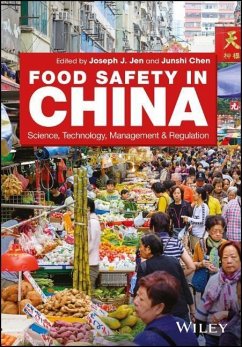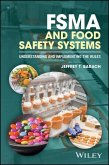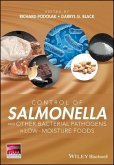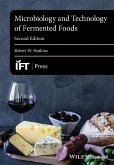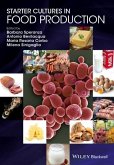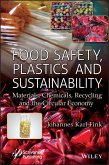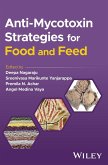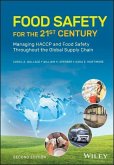Food Safety in China
Science, Technology, Management and Regulation
Herausgegeben:Jen, Joseph Jwu-Shan; Chen, Junshi
Food Safety in China
Science, Technology, Management and Regulation
Herausgegeben:Jen, Joseph Jwu-Shan; Chen, Junshi
- Gebundenes Buch
- Merkliste
- Auf die Merkliste
- Bewerten Bewerten
- Teilen
- Produkt teilen
- Produkterinnerung
- Produkterinnerung
From contaminated infant formula to a spate of all-too familiar headlines in recent years, food safety has emerged as one of the harsher realities behind China's economic miracle. Tainted beef, horse meat and dioxin outbreaks in the western world have also put food safety in the global spotlight.
Food Safety in China: Science, Technology, Management and Regulation presents a comprehensive overview of the history and current state of food safety in China, along with emerging regulatory trends and the likely future needs of the country. Although the focus is on China, global perspectives are…mehr
Andere Kunden interessierten sich auch für
![Fsma and Food Safety Systems Fsma and Food Safety Systems]() Jeffrey T. BarachFsma and Food Safety Systems77,99 €
Jeffrey T. BarachFsma and Food Safety Systems77,99 €![Control of Salmonella and Other Bacterial Pathogens in Low-Moisture Foods Control of Salmonella and Other Bacterial Pathogens in Low-Moisture Foods]() Control of Salmonella and Other Bacterial Pathogens in Low-Moisture Foods228,99 €
Control of Salmonella and Other Bacterial Pathogens in Low-Moisture Foods228,99 €![Microbiology and Technology of Fermented Foods Microbiology and Technology of Fermented Foods]() Robert W. HutkinsMicrobiology and Technology of Fermented Foods126,99 €
Robert W. HutkinsMicrobiology and Technology of Fermented Foods126,99 €![Starter Cultures in Food Production Starter Cultures in Food Production]() Starter Cultures in Food Production210,99 €
Starter Cultures in Food Production210,99 €![Food Safety, Plastics and Sustainability Food Safety, Plastics and Sustainability]() Johannes Karl FinkFood Safety, Plastics and Sustainability222,99 €
Johannes Karl FinkFood Safety, Plastics and Sustainability222,99 €![Anti-Mycotoxin Strategies for Food and Feed Anti-Mycotoxin Strategies for Food and Feed]() Anti-Mycotoxin Strategies for Food and Feed104,99 €
Anti-Mycotoxin Strategies for Food and Feed104,99 €![Food Safety for the 21st Century Food Safety for the 21st Century]() Carol A. WallaceFood Safety for the 21st Century151,99 €
Carol A. WallaceFood Safety for the 21st Century151,99 €-
-
-
From contaminated infant formula to a spate of all-too familiar headlines in recent years, food safety has emerged as one of the harsher realities behind China's economic miracle. Tainted beef, horse meat and dioxin outbreaks in the western world have also put food safety in the global spotlight.
Food Safety in China: Science, Technology, Management and Regulation presents a comprehensive overview of the history and current state of food safety in China, along with emerging regulatory trends and the likely future needs of the country. Although the focus is on China, global perspectives are presented in the chapters and 33 of the 99 authors are from outside of China.
Timely and illuminating, this book offers invaluable insights into our understanding of a critical link in the increasingly globalized complex food supply chain of today's world.
Food Safety in China: Science, Technology, Management and Regulation presents a comprehensive overview of the history and current state of food safety in China, along with emerging regulatory trends and the likely future needs of the country. Although the focus is on China, global perspectives are presented in the chapters and 33 of the 99 authors are from outside of China.
Timely and illuminating, this book offers invaluable insights into our understanding of a critical link in the increasingly globalized complex food supply chain of today's world.
Produktdetails
- Produktdetails
- Verlag: Wiley / Wiley & Sons
- Artikelnr. des Verlages: 1W119237960
- 1. Auflage
- Seitenzahl: 696
- Erscheinungstermin: 8. Mai 2017
- Englisch
- Abmessung: 246mm x 170mm x 30mm
- Gewicht: 1315g
- ISBN-13: 9781119237969
- ISBN-10: 1119237963
- Artikelnr.: 47714879
- Herstellerkennzeichnung
- Libri GmbH
- Europaallee 1
- 36244 Bad Hersfeld
- gpsr@libri.de
- Verlag: Wiley / Wiley & Sons
- Artikelnr. des Verlages: 1W119237960
- 1. Auflage
- Seitenzahl: 696
- Erscheinungstermin: 8. Mai 2017
- Englisch
- Abmessung: 246mm x 170mm x 30mm
- Gewicht: 1315g
- ISBN-13: 9781119237969
- ISBN-10: 1119237963
- Artikelnr.: 47714879
- Herstellerkennzeichnung
- Libri GmbH
- Europaallee 1
- 36244 Bad Hersfeld
- gpsr@libri.de
About the editors Joseph J. Jen is the co-chair of the Food Safety Expert Panel of the International Union of Food Science and Technology, chair of the Advisory Council of Bor S. Luh Food Safety Research Center, Shanghai Jaio Tong University, and the editor of Food Control. Dr. Jen was also a former undersecretary of US Department of Agriculture in charge of Research, Education and Economics. Junshi Chen is a senior advisor at the China National Center for Food Safety Risk Assessment. Dr. Chen is first academician from the food science and nutrition field in China, and the most respected scientist in these fields. He is also the official representative of China for the CODEX Alimentarius.
Part 1 Introduction 1
1 Shared Responsibility of Food Safety 3
Joseph J. Jen
1.1 Introduction 3
1.2 History 5
1.3 The Food Chain and Food Safety Laws 6
1.4 Current Status 8
1.5 The Future 11
2 Overview of Food Safety Situation in China 15
Junshi Chen and Zhiqiang Zhang
2.1 Introduction 15
2.2 The Past (1995-2009) 16
2.3 Present (2009-2015) 19
2.4 Major Food Safety Issues at Present 22
2.5 Looking Forward 26
2.6 Summary 27
3 Food Safety Education and Training Programs in China 29
Yao?]wen Huang
3.1 Introduction 29
3.2 Definitions of Food Safety Problems 30
3.3 Food Poisoning Incidents 31
3.4 Food Safety Education and Training 32
3.5 Summary 41
4 Development of the Food Industry in China 43
Suhe Meng and Joseph J. Jen
4.1 Introduction 43
4.2 Background Information 43
4.3 Current Status 45
4.5 Challenges 48
4.6 Future Development 50
Part 2 Food Microbiology 53
5 Food-borne Diseases and Surveillance 55
Yunchang Guo, Shuyu Wu and Jianghui Zhu
5.1 Introduction 55
5.2 The Past (-2010) 56
5.3 Present (2010~) 57
5.4 The Future 60
5.5 Brief Summary 61
6 Food-borne Pathogenic Bacteria 65
Xianming Shi, Yanping Xie and Xiujuan Zhou
6.1 Introduction to Bacterial Food Poisoning 65
6.2 Important Food-borne Pathogenic Bacteria 66
6.3 Frequent Vehicles of Food-borne Pathogens 70
6.4 Prevention and Control of Bacterial Food Poisoning 73
6.5 Principles of Prevention and Control 74
6.6 Future Aspects 76
6.7 Risk Assessment of Food-borne Pathogens 77
7 Mycotoxins in China: Occurrence and Exposure 83
Yunyun Gong, Fengqin Li and Michael N. Routledge
7.1 Introduction to Mycotoxins 83
7.2 Aflatoxin 84
7.3 Fumonisins 87
7.4 DON 89
7.5 T-2 Toxin 92
7.6 ZEN 92
7.7 Combined Exposures 94
7.8 Regulations, Control and Surveillance 95
7.9 Challenges 96
8 Viruses 103
Jennifer L. Cannon, Lingling Liu and Wei Kang
8.1 Introduction 103
8.2 Overview of Specific Food-borne Viruses Important in China and Globally 104
8.3 The Current Status of Food-borne Viruses in China 111
8.4 Future Perspectives for Food-borne Viruses in China 117
9 Food-borne Parasitic Diseases in China 127
Xue Bai, Xiaolei Liu, Xiaonong Zhou, Jiaxu Chen, Xiuping Wu, Pascal Boireau and Mingyuan Liu
9.1 Epidemic Features of Major Food-borne Parasitic Diseases in China 129
9.2 Diagnostic Technologies for Food-borne Parasitic Diseases in China 134
9.3 Management and Regulation of Food-borne Parasitic Diseases in China 138
10 Natural Antimicrobials from Herbs and Spices 147
P. Michael Davidson
10.1 Food Preservation 147
10.2 Antimicrobial Food Preservatives 147
10.3 Spices and Herbs as Natural Antimicrobials 148
10.4 Considerations in Using Essential Oils as Natural Antimicrobials in Foods 156
11 Antimicrobial Resistance in Food-Related Bacteria 163
Fengqin Li and Seamus Fanning
11.1 Introduction 163
11.2 Salmonella Species 165
11.3 Escherichia coli 169
11.4 Staphylococcus aureus 171
11.5 Campylobacter species 172
11.6 Listeria monocytogenes 173
11.7 Enterococcus species 176
11.8 Lactic Acid Bacteria (LAB) 178
11.9 Concluding
1 Shared Responsibility of Food Safety 3
Joseph J. Jen
1.1 Introduction 3
1.2 History 5
1.3 The Food Chain and Food Safety Laws 6
1.4 Current Status 8
1.5 The Future 11
2 Overview of Food Safety Situation in China 15
Junshi Chen and Zhiqiang Zhang
2.1 Introduction 15
2.2 The Past (1995-2009) 16
2.3 Present (2009-2015) 19
2.4 Major Food Safety Issues at Present 22
2.5 Looking Forward 26
2.6 Summary 27
3 Food Safety Education and Training Programs in China 29
Yao?]wen Huang
3.1 Introduction 29
3.2 Definitions of Food Safety Problems 30
3.3 Food Poisoning Incidents 31
3.4 Food Safety Education and Training 32
3.5 Summary 41
4 Development of the Food Industry in China 43
Suhe Meng and Joseph J. Jen
4.1 Introduction 43
4.2 Background Information 43
4.3 Current Status 45
4.5 Challenges 48
4.6 Future Development 50
Part 2 Food Microbiology 53
5 Food-borne Diseases and Surveillance 55
Yunchang Guo, Shuyu Wu and Jianghui Zhu
5.1 Introduction 55
5.2 The Past (-2010) 56
5.3 Present (2010~) 57
5.4 The Future 60
5.5 Brief Summary 61
6 Food-borne Pathogenic Bacteria 65
Xianming Shi, Yanping Xie and Xiujuan Zhou
6.1 Introduction to Bacterial Food Poisoning 65
6.2 Important Food-borne Pathogenic Bacteria 66
6.3 Frequent Vehicles of Food-borne Pathogens 70
6.4 Prevention and Control of Bacterial Food Poisoning 73
6.5 Principles of Prevention and Control 74
6.6 Future Aspects 76
6.7 Risk Assessment of Food-borne Pathogens 77
7 Mycotoxins in China: Occurrence and Exposure 83
Yunyun Gong, Fengqin Li and Michael N. Routledge
7.1 Introduction to Mycotoxins 83
7.2 Aflatoxin 84
7.3 Fumonisins 87
7.4 DON 89
7.5 T-2 Toxin 92
7.6 ZEN 92
7.7 Combined Exposures 94
7.8 Regulations, Control and Surveillance 95
7.9 Challenges 96
8 Viruses 103
Jennifer L. Cannon, Lingling Liu and Wei Kang
8.1 Introduction 103
8.2 Overview of Specific Food-borne Viruses Important in China and Globally 104
8.3 The Current Status of Food-borne Viruses in China 111
8.4 Future Perspectives for Food-borne Viruses in China 117
9 Food-borne Parasitic Diseases in China 127
Xue Bai, Xiaolei Liu, Xiaonong Zhou, Jiaxu Chen, Xiuping Wu, Pascal Boireau and Mingyuan Liu
9.1 Epidemic Features of Major Food-borne Parasitic Diseases in China 129
9.2 Diagnostic Technologies for Food-borne Parasitic Diseases in China 134
9.3 Management and Regulation of Food-borne Parasitic Diseases in China 138
10 Natural Antimicrobials from Herbs and Spices 147
P. Michael Davidson
10.1 Food Preservation 147
10.2 Antimicrobial Food Preservatives 147
10.3 Spices and Herbs as Natural Antimicrobials 148
10.4 Considerations in Using Essential Oils as Natural Antimicrobials in Foods 156
11 Antimicrobial Resistance in Food-Related Bacteria 163
Fengqin Li and Seamus Fanning
11.1 Introduction 163
11.2 Salmonella Species 165
11.3 Escherichia coli 169
11.4 Staphylococcus aureus 171
11.5 Campylobacter species 172
11.6 Listeria monocytogenes 173
11.7 Enterococcus species 176
11.8 Lactic Acid Bacteria (LAB) 178
11.9 Concluding
Part 1 Introduction 1
1 Shared Responsibility of Food Safety 3
Joseph J. Jen
1.1 Introduction 3
1.2 History 5
1.3 The Food Chain and Food Safety Laws 6
1.4 Current Status 8
1.5 The Future 11
2 Overview of Food Safety Situation in China 15
Junshi Chen and Zhiqiang Zhang
2.1 Introduction 15
2.2 The Past (1995-2009) 16
2.3 Present (2009-2015) 19
2.4 Major Food Safety Issues at Present 22
2.5 Looking Forward 26
2.6 Summary 27
3 Food Safety Education and Training Programs in China 29
Yao?]wen Huang
3.1 Introduction 29
3.2 Definitions of Food Safety Problems 30
3.3 Food Poisoning Incidents 31
3.4 Food Safety Education and Training 32
3.5 Summary 41
4 Development of the Food Industry in China 43
Suhe Meng and Joseph J. Jen
4.1 Introduction 43
4.2 Background Information 43
4.3 Current Status 45
4.5 Challenges 48
4.6 Future Development 50
Part 2 Food Microbiology 53
5 Food-borne Diseases and Surveillance 55
Yunchang Guo, Shuyu Wu and Jianghui Zhu
5.1 Introduction 55
5.2 The Past (-2010) 56
5.3 Present (2010~) 57
5.4 The Future 60
5.5 Brief Summary 61
6 Food-borne Pathogenic Bacteria 65
Xianming Shi, Yanping Xie and Xiujuan Zhou
6.1 Introduction to Bacterial Food Poisoning 65
6.2 Important Food-borne Pathogenic Bacteria 66
6.3 Frequent Vehicles of Food-borne Pathogens 70
6.4 Prevention and Control of Bacterial Food Poisoning 73
6.5 Principles of Prevention and Control 74
6.6 Future Aspects 76
6.7 Risk Assessment of Food-borne Pathogens 77
7 Mycotoxins in China: Occurrence and Exposure 83
Yunyun Gong, Fengqin Li and Michael N. Routledge
7.1 Introduction to Mycotoxins 83
7.2 Aflatoxin 84
7.3 Fumonisins 87
7.4 DON 89
7.5 T-2 Toxin 92
7.6 ZEN 92
7.7 Combined Exposures 94
7.8 Regulations, Control and Surveillance 95
7.9 Challenges 96
8 Viruses 103
Jennifer L. Cannon, Lingling Liu and Wei Kang
8.1 Introduction 103
8.2 Overview of Specific Food-borne Viruses Important in China and Globally 104
8.3 The Current Status of Food-borne Viruses in China 111
8.4 Future Perspectives for Food-borne Viruses in China 117
9 Food-borne Parasitic Diseases in China 127
Xue Bai, Xiaolei Liu, Xiaonong Zhou, Jiaxu Chen, Xiuping Wu, Pascal Boireau and Mingyuan Liu
9.1 Epidemic Features of Major Food-borne Parasitic Diseases in China 129
9.2 Diagnostic Technologies for Food-borne Parasitic Diseases in China 134
9.3 Management and Regulation of Food-borne Parasitic Diseases in China 138
10 Natural Antimicrobials from Herbs and Spices 147
P. Michael Davidson
10.1 Food Preservation 147
10.2 Antimicrobial Food Preservatives 147
10.3 Spices and Herbs as Natural Antimicrobials 148
10.4 Considerations in Using Essential Oils as Natural Antimicrobials in Foods 156
11 Antimicrobial Resistance in Food-Related Bacteria 163
Fengqin Li and Seamus Fanning
11.1 Introduction 163
11.2 Salmonella Species 165
11.3 Escherichia coli 169
11.4 Staphylococcus aureus 171
11.5 Campylobacter species 172
11.6 Listeria monocytogenes 173
11.7 Enterococcus species 176
11.8 Lactic Acid Bacteria (LAB) 178
11.9 Concluding
1 Shared Responsibility of Food Safety 3
Joseph J. Jen
1.1 Introduction 3
1.2 History 5
1.3 The Food Chain and Food Safety Laws 6
1.4 Current Status 8
1.5 The Future 11
2 Overview of Food Safety Situation in China 15
Junshi Chen and Zhiqiang Zhang
2.1 Introduction 15
2.2 The Past (1995-2009) 16
2.3 Present (2009-2015) 19
2.4 Major Food Safety Issues at Present 22
2.5 Looking Forward 26
2.6 Summary 27
3 Food Safety Education and Training Programs in China 29
Yao?]wen Huang
3.1 Introduction 29
3.2 Definitions of Food Safety Problems 30
3.3 Food Poisoning Incidents 31
3.4 Food Safety Education and Training 32
3.5 Summary 41
4 Development of the Food Industry in China 43
Suhe Meng and Joseph J. Jen
4.1 Introduction 43
4.2 Background Information 43
4.3 Current Status 45
4.5 Challenges 48
4.6 Future Development 50
Part 2 Food Microbiology 53
5 Food-borne Diseases and Surveillance 55
Yunchang Guo, Shuyu Wu and Jianghui Zhu
5.1 Introduction 55
5.2 The Past (-2010) 56
5.3 Present (2010~) 57
5.4 The Future 60
5.5 Brief Summary 61
6 Food-borne Pathogenic Bacteria 65
Xianming Shi, Yanping Xie and Xiujuan Zhou
6.1 Introduction to Bacterial Food Poisoning 65
6.2 Important Food-borne Pathogenic Bacteria 66
6.3 Frequent Vehicles of Food-borne Pathogens 70
6.4 Prevention and Control of Bacterial Food Poisoning 73
6.5 Principles of Prevention and Control 74
6.6 Future Aspects 76
6.7 Risk Assessment of Food-borne Pathogens 77
7 Mycotoxins in China: Occurrence and Exposure 83
Yunyun Gong, Fengqin Li and Michael N. Routledge
7.1 Introduction to Mycotoxins 83
7.2 Aflatoxin 84
7.3 Fumonisins 87
7.4 DON 89
7.5 T-2 Toxin 92
7.6 ZEN 92
7.7 Combined Exposures 94
7.8 Regulations, Control and Surveillance 95
7.9 Challenges 96
8 Viruses 103
Jennifer L. Cannon, Lingling Liu and Wei Kang
8.1 Introduction 103
8.2 Overview of Specific Food-borne Viruses Important in China and Globally 104
8.3 The Current Status of Food-borne Viruses in China 111
8.4 Future Perspectives for Food-borne Viruses in China 117
9 Food-borne Parasitic Diseases in China 127
Xue Bai, Xiaolei Liu, Xiaonong Zhou, Jiaxu Chen, Xiuping Wu, Pascal Boireau and Mingyuan Liu
9.1 Epidemic Features of Major Food-borne Parasitic Diseases in China 129
9.2 Diagnostic Technologies for Food-borne Parasitic Diseases in China 134
9.3 Management and Regulation of Food-borne Parasitic Diseases in China 138
10 Natural Antimicrobials from Herbs and Spices 147
P. Michael Davidson
10.1 Food Preservation 147
10.2 Antimicrobial Food Preservatives 147
10.3 Spices and Herbs as Natural Antimicrobials 148
10.4 Considerations in Using Essential Oils as Natural Antimicrobials in Foods 156
11 Antimicrobial Resistance in Food-Related Bacteria 163
Fengqin Li and Seamus Fanning
11.1 Introduction 163
11.2 Salmonella Species 165
11.3 Escherichia coli 169
11.4 Staphylococcus aureus 171
11.5 Campylobacter species 172
11.6 Listeria monocytogenes 173
11.7 Enterococcus species 176
11.8 Lactic Acid Bacteria (LAB) 178
11.9 Concluding

